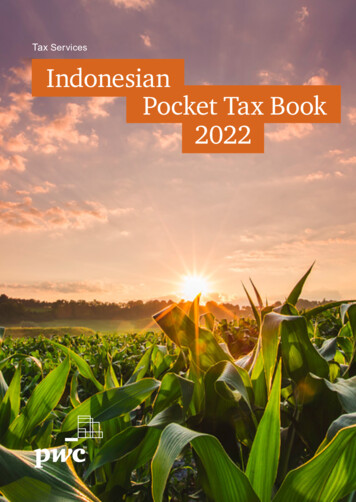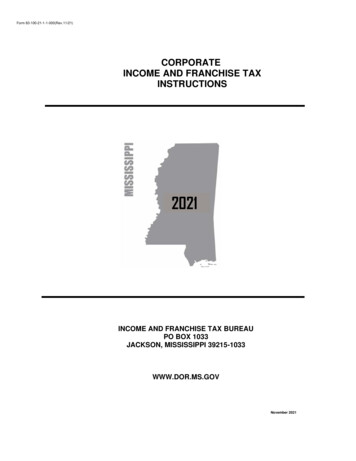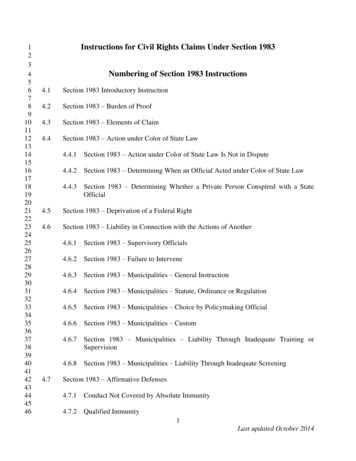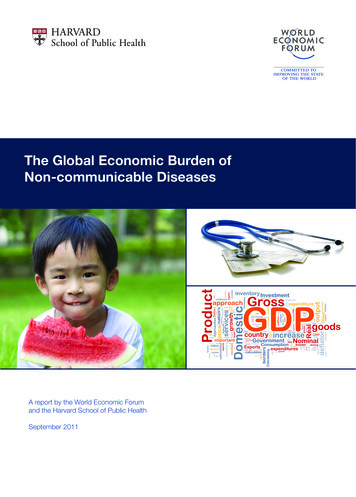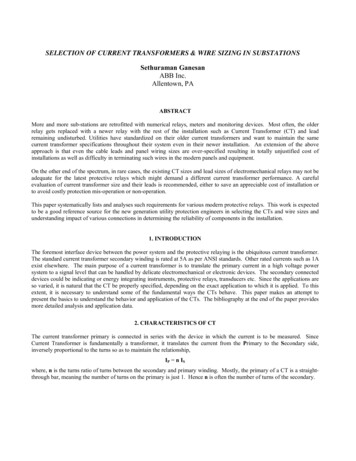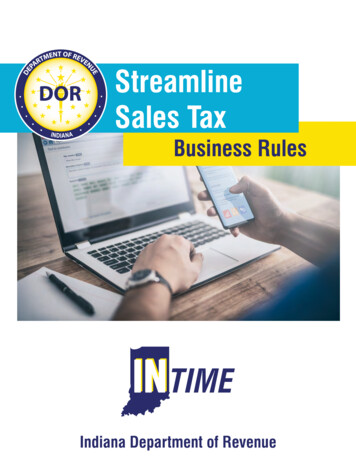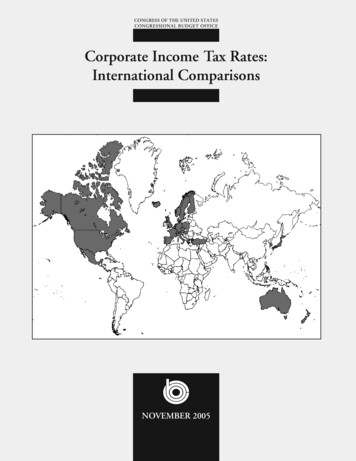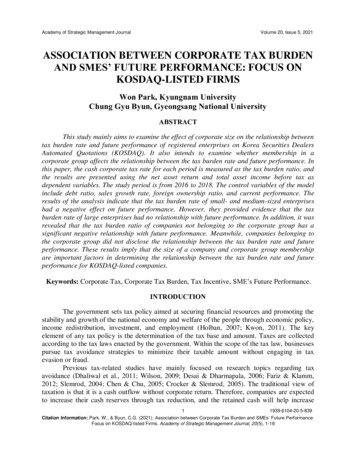
Transcription
Academy of Strategic Management JournalVolume 20, Issue 5, 2021ASSOCIATION BETWEEN CORPORATE TAX BURDENAND SMES’ FUTURE PERFORMANCE: FOCUS ONKOSDAQ-LISTED FIRMSWon Park, Kyungnam UniversityChung Gyu Byun, Gyeongsang National UniversityABSTRACTThis study mainly aims to examine the effect of corporate size on the relationship betweentax burden rate and future performance of registered enterprises on Korea Securities DealersAutomated Quotations (KOSDAQ). It also intends to examine whether membership in acorporate group affects the relationship between the tax burden rate and future performance. Inthis paper, the cash corporate tax rate for each period is measured as the tax burden ratio, andthe results are presented using the net asset return and total asset income before tax asdependent variables. The study period is from 2016 to 2018. The control variables of the modelinclude debt ratio, sales growth rate, foreign ownership ratio, and current performance. Theresults of the analysis indicate that the tax burden rate of small- and medium-sized enterpriseshad a negative effect on future performance. However, they provided evidence that the taxburden rate of large enterprises had no relationship with future performance. In addition, it wasrevealed that the tax burden ratio of companies not belonging to the corporate group has asignificant negative relationship with future performance. Meanwhile, companies belonging tothe corporate group did not disclose the relationship between the tax burden rate and futureperformance. These results imply that the size of a company and corporate group membershipare important factors in determining the relationship between the tax burden rate and futureperformance for KOSDAQ-listed companies.Keywords: Corporate Tax, Corporate Tax Burden, Tax Incentive, SME’s Future Performance.INTRODUCTIONThe government sets tax policy aimed at securing financial resources and promoting thestability and growth of the national economy and welfare of the people through economic policy,income redistribution, investment, and employment (Holban, 2007; Kwon, 2011). The keyelement of any tax policy is the determination of the tax base and amount. Taxes are collectedaccording to the tax laws enacted by the government. Within the scope of the tax law, businessespursue tax avoidance strategies to minimize their taxable amount without engaging in taxevasion or fraud.Previous tax-related studies have mainly focused on research topics regarding taxavoidance (Dhaliwal et al., 2011; Wilson, 2009; Desai & Dharmapala, 2006; Fariz & Klamm,2012; Slemrod, 2004; Chen & Chu, 2005; Crocker & Slemrod, 2005). The traditional view oftaxation is that it is a cash outflow without corporate return. Therefore, companies are expectedto increase their cash reserves through tax reduction, and the retained cash will help increase11939-6104-20-5-839Citation Information: Park. W., & Byun, C.G. (2021). Association between Corporate Tax Burden and SMEs’ Future Performance:Focus on KOSDAQ-listed Firms. Academy of Strategic Management Journal, 20(5), 1-19.
Academy of Strategic Management JournalVolume 20, Issue 5, 2021their corporate value or future performance through investment. It refers to the transfer ofcorporate resources from the government to shareholders through tax avoidance. However,recently, tax reduction has been confused with the concept of tax evasion, and tax evasion isrecognized as an opportunistic behavior of managers and considered a cause of lower corporatevalue (Hanlon & Slemrod, 2009; Dhaliwal et al., 2011; Desai & Dharmapala, 2006).Tax avoidance related to managerial ability is believed to increase corporate value, andthis tax strategy can hold cash and promote corporate growth. However, tax evasion is regardedas an opportunistic act of managers who failed to maximize shareholder wealth, related tomanagers’ pursuit of private profit, and considered a factor that caused managers’ agencyproblem and increased agency costs. Chief executive officers (CEOs) must have a sense ofresponsibility for a company and play a critical role in the success and failure of the company.However, a literature study on the relationship between managerial leadership and responsibilitywas barely conducted (Melo et al., 2020). Therefore, in tax accounting studies, opinions on theperformance or value of companies in relation to tax strategies have conflicted. However, theempirical analysis of tax avoidance studies is not applicable to all companies, but it can beapplied to large corporations with high taxable income and relatively low tax benefits.Small- and medium-sized enterprises (SMEs) have a relatively low taxable income, andtheir desire to avoid tax due to tax benefits is significantly lower than that of large-sizedenterprises. Therefore, SMEs and large corporations have different taxation environments anddifferent tax burdens, so they should be separately verified. Given that SMEs are short of cashand have difficulty raising funds, their expected outflow of cash may have a greater tax burdenthan those of large-sized enterprises. Therefore, conducting verification separately from SMEsand large-sized enterprises is necessary. As a strategic factor that moves an organization, thefactor that determines the performance of a company is innovation (Tajpour et al., 2020),wherein differences can exist depending on the size (Tajpour et al., 2018). Given that SMEs havedifficulties in responding to technological change in a sensitively changing industry due to a lackof a management process that can support customers (Castagna et al., 2020); they require supportfor survival and maintenance.Tax avoidance strategies may vary according to company size. Tax evasion by largefirms is subject to strict legal consequences. SMEs have a lower tax burden owing to taxincentives, such as reduced rates or special tax exemption (Kwon, 2011; Lee & Lho, 2002; Lee& Jun, 2017). However, compared with SMEs, large firms are less burdened by tax-related cashoutflow because they can easily raise funds and have the means to maintain their level of cashholdings, with easy access to cash to continue to carry out investment activities or increase theirfinancial resources. Meanwhile, SMEs tend to have limited cash flow (Aderemi, 2003), and theirperformance often depends on cost reduction. For SMEs, cash shortages owing to tax paymentsaffect liquidity (Tomlin, 2008), which may have adverse consequences on future corporateperformance by affecting investment or other expenditures. That is, a high tax burden imposedon a small company can negatively affect the latter’s future performance.The present study aimed to investigate the association between SMEs’ corporate taxburden and future performance. We distinguished between SMEs affiliated and unaffiliated withlarge corporate groups, given that the former is ineligible for tax incentives granted to SMEsdespite that they fall under the SME category in terms of sales and firm size. We evaluated futureperformance by adopting an approach that reflected size-dependent differentiation rather thanapplying a uniform standard. The significance of this study is that, given the differences in laws21939-6104-20-5-839Citation Information: Park. W., & Byun, C.G. (2021). Association between Corporate Tax Burden and SMEs’ Future Performance:Focus on KOSDAQ-listed Firms. Academy of Strategic Management Journal, 20(5), 1-19.
Academy of Strategic Management JournalVolume 20, Issue 5, 2021and regulations applicable to large firms and SMEs, it highlighted the importance of consideringdifferent taxation regimes for large firms and SMEs. Previous studies mainly focused on therelationship between tax burden ratio and corporate value or tax avoidance and corporateperformance (Slemrod, 2004, Chen & Chu, 2005). Meanwhile, the present study investigated theeffect of the differences between SMEs and large corporations on the relationship between taxburden ratio and future performance. In addition, it examined the relationship between the taxburden rate and future performance of corporate groups from the perspective of corporategovernance. This study found important variables in the relationship between tax burden rate andfuture performance that were not considered in previous studies in this field. The decisive role ofsize and corporate governance in the relationship between the tax burden rate and a company’sfuture performance has the following important implications. First, the study provides newevidence for the need of tax benefits for SMEs. The tax benefit policy of SMEs can reduce thetax burden of these enterprises, and this reduction in cash outflow can be a driving force to createfuture performance and can help develop and grow SMEs in the future. Second, corporate groupsof Korean companies have social problems, such as insider trading and forced work, and theability of SMEs that are not affiliated with these large companies to hold cash plays an importantrole in creating future performance. Moreover, tax burden plays a negative role in performancecreation. Finally, the results do not only emphasize the importance of tax benefits as a socialsystem that contributes to the growth and development of SMEs but also prove the importance oftax in terms of cash holdings.LITERATURE REVIEWTaxation-Related Theoretical BackgroundTaxation is a system of levies or taxes collected by state or provincial authorities toinduce an effective supply of public goods and the fair redistribution of income gained fromeconomic activities and to implement policy goals, such as preventing the extreme concentrationof wealth and ensuring the stability and growth of the national economy. The tax systemimplements levy schemes aimed at achieving economic efficiency, consumption control,monopoly regulation, prevention of urban overcrowding, and control of land price increase aspolicy goals. Various taxes are imposed on companies under the tax system, including corporateincome, value-added, and local taxes, ultimately leading to cash outflow from the companies asexpenses without direct offset.Firms need efficient tax planning, which is defined as maximizing the after-tax rate ofreturn, considering all costs—both tax and non-tax costs (Scholes et al., 2016). Graham &Tucker(2006) analyzed U.S. firms engaged in tax shelters, and they found that these firms tend to have8% lower pretax liabilities and tax shelter-related tax savings amounting to 9% of the total assets,much larger than the interest tax deductions for comparable firms. They [8] attributed theseresults to the influence of tax shelters on capital structure decisions, with the tax shelters used asnon-debt tax shields, substituting for interest tax deductions. Slemrod (2004), Chen & Chu(2005), and Crocker & Slemrod (2005) assumed the existence of agency costs in a corporateenvironment of separate ownership and management, and they presented a theoretical model toexplain the significant impact of such an environment on tax strategies. Slemrod (2004) proposedthe principal–agent framework to analyze the tax strategies of companies with separateownership and management, such as listed companies. Chen & Chu (2005) analyzed tax31939-6104-20-5-839Citation Information: Park. W., & Byun, C.G. (2021). Association between Corporate Tax Burden and SMEs’ Future Performance:Focus on KOSDAQ-listed Firms. Academy of Strategic Management Journal, 20(5), 1-19.
Academy of Strategic Management JournalVolume 20, Issue 5, 2021strategies using a principal–agent model, focusing on the efficiency loss owing to the separationof ownership and management. Crocker & Slemrod (2005) reviewed the compensation contractsfor executives who determine taxable income, paying attention to the relative efficacy of taxpenalties on principal–agent relations.Desai et al. (2007) noted that tax authorities reduce the agency problem throughmonitoring activities to reduce managerial diversion; they argued that corporate governanceinfluences the corporate response to changes in tax rates. Desai & Dharmapala (2006), in a studythat extended the literature on the principal–agent framework of tax planning strategies,constructed a model to explain the effect of incentives and corporate governance on taxsheltering from the corporate owners’ perspective. They concluded that incentive compensationand corporate governance arrangements are major determinants of sheltering decisions amongU.S. firms.Armstrong et al. (2015) performed a quantile regression to examine the associationbetween corporate governance and tax savings, and they argued that tax avoidance detrimental tocorporate value can be reduced by improving corporate governance. Shackelford and Shevlin(2001) noted that corporate governance plays a role in enhancing corporate value throughefficient resource allocation and is an important factor in tax savings. Chen et al. (2010) analyzedthe non-tax costs of family firms with equity ownership imbalance and found that tax avoidancemay be reduced by reducing total tax costs.Dyreng et al. (2008) found that tax risk arising from tax avoidance varies among firmsand that tax planning is performed in a stable manner, which stabilizes the volatility of stockprices and maintains a reliable corporate information environment. Such an environment allowsthe assumption that legally acceptable tax planning strategies would not induce tax-savingactivities to increase tax risk or decrease corporate value. Wilson (2009) investigated whethermanagers engaged in tax sheltering intend to maximize shareholders’ wealth or pursue their owninterests, and they found that tax shelter firms with strong corporate governance havesignificantly positive surplus returns, compared with those with weak corporate governance,according to paired samples t-test results. Their analysis with a large-scale sample set predictedto engage in tax sheltering yielded the same results. These findings are consistent with theargument that tax shelter strategies can increase corporate value in firms with good corporategovernance.Managers engage in tax avoidance activities mainly to transfer taxable financial resourcesto companies (Son et al., 2012). Thus, tax avoidance is used as a tax planning strategy to enhancefirm value by saving tax costs through the aggressive tax behavior of retaining taxable costs inthe company and thus increasing the resources distributed to the investors. However, excessivetax avoidance carries the risk of prompting additional collection and penalty. Hence, firms seekto explore the optimum level of safe tax avoidance. Typically, managers are incentivized toincrease the level of tax avoidance in pursuit of short-term profits. Desai & Dharmapala (2006)verified a significant negative relation between high managerial incentives and the level of theirtax avoidance arrangements. In their study, managers of firms with poor corporate governance—characterized by low transparency, large information asymmetry, and consequent difficulty forexternal investors to monitor managerial behavior—are assumed to use tax avoidance as anopportunity to pursue private interests.Huseynov & Klamm (2012) performed the first empirical analysis of the effect of threemeasures of corporate social responsibility—corporate governance, community, and diversity—41939-6104-20-5-839Citation Information: Park. W., & Byun, C.G. (2021). Association between Corporate Tax Burden and SMEs’ Future Performance:Focus on KOSDAQ-listed Firms. Academy of Strategic Management Journal, 20(5), 1-19.
Academy of Strategic Management JournalVolume 20, Issue 5, 2021on tax avoidance strategies and tax management in U.S. firms that use external auditors’ taxservices, and verified the positive effect of the interaction of the community with taxmanagement costs on both generally accepted accounting principles and effective tax rate (ETR)and a negative effect of the interaction of corporate governance and diversity with taxmanagement costs on cash ETR. Wang (2011) devised an opacity index to study the relationbetween corporate transparency, tax avoidance, and corporate value and argued that corporatetransparency has a moderating effect on the relation between tax avoidance and corporate value.Francis et al. (2013) found that expert managers are more sensitive to managerial reputation andare likely to avoid aggressive tax avoidance arrangements. They assumed that direct (e.g.,arrears, fines, and tax investigations by tax authorities) and indirect costs (e.g., capital, proxy,and reputation costs) associated with tax avoidance would have a negative effect on corporatevalue. Moreover, firms with a high level of tax avoidance are assumed to face increasedexpenditures by running the risk of incurring higher costs of debt owing to a lack of managerialtransparency. Aggressive tax strategies are accompanied by complex transaction forms andunnecessary organizational changes intended to avoid being tracked by the tax authorities. Thesestrategies also increase information asymmetry between managers and external shareholders orinvestors by restricting the disclosure of information, resulting in lower corporate transparency.SMEs eligible for various tax incentives are less likely to undertake tax avoidancearrangements than larger firms, and conventional notions of corporate tax burden or tax risk maynot apply to them. Given that firms seek ways to reduce tax costs (Son et al., 2012; Kang & Kim,2012), a complicated tax policy or high corporate tax burden can undermine corporate efficiencyand erode cash flows. In particular, corporate tax burden can impede the growth of SMEs, whoseaccounting information transparency is lower than that of listed firms (Farzbod, 2000; Kasipillai,2004; Yaobin, 2007; Weichenrieder, 2007). Thus, government or tax authorities can implementlegal tax policies within the purview of the law to reduce the tax burden on SMEs (Masato,2009). Typical tax incentives granted to SMEs in Korea include tax credits under the Restrictionof Special Taxation Act, tax reduction and exemption schemes, and tax support provided by taxauthorities.Each country has its own classification of SMEs eligible for tax incentives set out indifferent laws or guidelines, depending on the characteristics of individual industries and timing.In Korea, an SME is defined in Article 2 (1) of the Framework Act on Small and MediumEnterprises (Article 2, Paragraph 1) as follows: “An SME shall, by industry, satisfy the criteriasuch as the number of full-time employees, capital amount, total sales or total assets, etc. as wellas another standard of substantial independence of management from ownership based onownership and investment relationship, as stipulated by the Presidential Decree.” Additionally,to compensate for the disadvantage of single-choice options for limitations on mutual investmentin applying the actual independence standard of ownership and management, the governmentapplies upper limits in cases where the number of full-time employees is equal to or exceeds1,000 and the amount of total assets is equal to or exceeds KRW 500 billion, even if otherconditions are met. A firm unaffiliated to a corporate group with total assets equal to orexceeding KRW 500 billion must not own more than 30% of the total number of issued shares. Acorporate group subject to limitations on mutual investment refers to a group of companiesbelonging to a conglomerate with minimum total assets of KRW 5 trillion (USD 4.25 billion). Alist of such corporate groups is released by an official notification of the Fair Trade Commissionon a monthly basis. In the case of a firm co-owned by another firm whose share exceeds 30%,51939-6104-20-5-839Citation Information: Park. W., & Byun, C.G. (2021). Association between Corporate Tax Burden and SMEs’ Future Performance:Focus on KOSDAQ-listed Firms. Academy of Strategic Management Journal, 20(5), 1-19.
Academy of Strategic Management JournalVolume 20, Issue 5, 2021the independence standard is not met when the total assets of the latter firm exceed KRW 500billion because the former, a co-owned firm, cannot be considered an entity independent of thelatter firm. Since 2018, Korea has recorded 3,809,011 SMEs nationwide across industries,accounting for 99.8% of all enterprises (3,813,723). SMEs account for 99.6% of the total numberof enterprises in the manufacturing industry (431,085 out of 432,815), 99.8% in the constructionindustry (142,240 out of 142,564), and 99.9% in the wholesale and retail businesses(1,0616,064).SMEs make up an absolute majority of the Korean economy and play a pivotal role ineconomic activities across the country. They are actively promoted under the Restriction ofSpecial Taxation Act for the balanced development of the national economy. Various taxincentives are available to SMEs, such as startup tax reduction/exemption and special tax rates,as preferential tax treatment over larger enterprises. For SME classification under the tax law, therequirements of industry type, size, independence, and graduation standards should be met. Theindustry type is determined by the Korean Standard Industrial Classification set out by theDirector General of Statistics Korea, except for special provisions under the Restriction ofSpecial Taxation Act. A firm’s size is determined by its sales and total assets. The cutoff for totalassets for SMEs is KRW 500 billion. The sales cutoff is stratified: KRW 150 billion for thetextiles, leather, pulp, and primary metal manufacturing sectors; KRW 100 billion for themining, grocery, agriculture, and construction sectors; KRW 80 billion for the wholesale andretail, drug manufacturing, transportation and warehousing, and ICT sectors; KRW 60 billion forthe professional, science and technology, health care, and arts service sectors; and KRW 40billion for the hospitality (lodging and restaurant) and finance sectors. The independencestandard for the classification of SMEs is as follows: among the firms affiliated with a corporategroup subject to limitations on cross-shareholding, as designated in Article 14 (1) of theMonopoly Regulation and Fair Trade Act, and the firms notified to be a member of a corporategroup subject to disclosure under Article 14 (3) of the same act, those unaffiliated with acorporate group subject to limitations on cross-shareholding fall under the category of SMEs.Details of the tax support policies for SMEs are outlined in Table 1.Studies have been conducted on the effectiveness of these preferential tax policies forSMEs. Lee & Loh (2002) analyzed the effects of direct and indirect tax support policies forSMEs in Korea and found that every 1% increase in direct tax support leads to a 0.707% increasein the total manufacturing output, whereas indirect tax support policies do not significantlyenhance the productivity and per capita value added. Thus, more emphasis needs to be given todirect than indirect tax support to enhance the growth potential and competitiveness of SMEs.Kwon (2011) examined the effectiveness of tax support for Korean SMEs and reported a positiveeffect on profitability and growth, but no significant effect on job creation. Tax support in theform of tax expenditures brings about tax losses and distortion of fairness and resourceallocation. Accordingly, Kwon (2011) recommended functionality support, such as R&D and jobcreation, rather than tax support in the choice of SME support policy. Na et al. (2014) found thatSMEs have a lower tax burden than larger firms and, thus, are less likely to attempt taxavoidance owing to a lower probability of cash outflow. A positive relation between tax burdenand firm size and tax reduction incentives among firms listed in the Korea Securities DealersAutomated Quotations (KOSDAQ). They investigated the effects of various SME-related taxincentives on added value, such as productivity, as well as the differences in tax avoidancepractices between SMEs and large companies and influencing factors.61939-6104-20-5-839Citation Information: Park. W., & Byun, C.G. (2021). Association between Corporate Tax Burden and SMEs’ Future Performance:Focus on KOSDAQ-listed Firms. Academy of Strategic Management Journal, 20(5), 1-19.
Academy of Strategic Management JournalVolume 20, Issue 5, 2021Table 1TAX SUPPORT POLITICS FOR SMALL- AND MEDIUM-SIZED ENTERPRISES (SMEs)StageDescriptionStartupInvestment andfundraisingBusinessFinancialimprovement andrestructuringIncome tax reduction of 50% for five years from the first year of income generationRegistration and license tax exemption, such as incorporation registrationAcquisition tax reduction of 75% on assets acquired within four years after startupProperty tax exemption for three years after startup, 50% reduction for two more yearsLow-rate gift tax (10%) on startup funds from parents over 60 years oldSME investment tax credit (3.4% of investment amount)Investment tax credit on amount spent on facilitiesIncome tax credit of 10% on amount funded by the Startup and Venture FundSpecial tax reduction or exemptionTax credit on research staff development expensesTax credit on facility investment for research and human resources developmentTax credit or exemption for technology transfer and technology acquisitionAdditional recognition of the standard amount of entertainment expensesPreferential tax treatment (application of a minimum tax) forTax support for mergersReduced capital gains taxes on core business changeReduced income tax (50%) for four years after a core business changeCapital gains tax carried forward on the conversion of a private firm to a public firmCapital gains tax deferral on investment in kind when establishing a holding companyReduced taxes on unlisted stock exchange for strategic alliance of venture firmsSource: Korea Tax Administration, 2015Extending the findings of previous studies, our study aimed to analyze the differences inthe effect of the tax burden on future performance between SMEs and large companies. One ofthe key reasons for tax reduction or exemption is inducing reinvestment by reducing cashoutflow or saving cash for future investments or performance creation. In this context, the effectof the tax burden on future performance is likely to be greater for SMEs than for large firms.Research HypothesesTax avoidance based on tax planning strategies that do not violate tax laws is regarded asmanagerial capability (Francis et al., 2013). Cash holdings retained through these efforts may beused to create value for a firm’s future performance (Son et al., 2012). The more competent themanagers, the more skilled they are at reducing tax costs, applying a cost–benefit approach to taxissues (Bankman, 1998). In the traditional view of tax costs, competent managers should be ableto reduce cash outflow and increase tax shelter investment to contribute to future performance(Blaylock et al., 2012). Bankman (1998) assumed that, for growing firms, successful tax shelterinvestments could have a more positive effect on performance and more competent executivesare better at resource allocation, particularly in using the saved tax money in reinvestment for thefuture growth of the company. Blaycok et al. (2012) found that excellent executives haveexcellent skills in reducing tax liabilities and expected them to achieve greater performance bymaking tax shelter investments in projects that maximize net present value. Thus, the corporatetax burden is lowered depending on the extent of managerial competence in corporate taxavoidance, leading to reduced cash outflow and contributing to future corporate performance.H1A firm’s tax burden has a negative effect on its future performance.71939-6104-20-5-839Citation Information: Park. W., & Byun, C.G. (2021). Association between Corporate Tax Burden and SMEs’ Future Performance:Focus on KOSDAQ-listed Firms. Academy of Strategic Management Journal, 20(5), 1-19.
Academy of Strategic Management JournalVolume 20, Issue 5, 2021In Korea, although tax support schemes vary according to the development stage, allSMEs are eligible for tax advantages aimed at SME promotion and growth. In other words, taxpolicies have been designed to promote SMEs and encourage investment activities. A higher taxrate is associated with a higher cash outflow, which impedes investment activities and inducesliquidity shortages. Unlike large firms, SMEs have difficulty raising financial resources and havea high share of borrowed funds involving interest payments. Therefore, the tax burden of anSME can negatively affect its future performance. In contrast, the future performance of largeand middle-standing enterprises is less likely to be affected by corporate tax burden because theyhave easier access to financial resources and are more likely to have sufficient cash reservesthrough retained income. Thus, the following hypotheses were established:H2-1H2-2The level of tax burden on SMEs negatively affects their future performance.The level of tax burden of large- and middle-standing enterprises does not affect their futureperformance.Our study considered not only the size of a firm but also its affiliation with a corporategroup in determining its eligibility to receive tax incentives for SMEs. An SME may operate asan independent company or as a member of a corporate group by forming a new company oracquiring an equity share in an operating company according to the strategic needs for businessgrowth or diversification. In tax issues, SMEs are classified into firms that belong to a corporategroup and those that do not. A corporate group refers to a group of firms affiliated with the samecontrolling shareholder and linked in the internal capital market through cross-shareholding ordebt guarantees.SMEs belonging to a corporate group have easier access to financial resources than thosethat do not because they can obtain collateral or payment guarantees from other membercompanies. Firms belonging to a corporate gr
Academy of Strategic Management Journal, 20(5), 1-19. their corporate value or future performance through investment. It refers to the transfer of corporate resources from the government to shareholders through tax avoidance. However, recently, tax reduction has been confused with the concept of tax evasion, and tax evasion is
